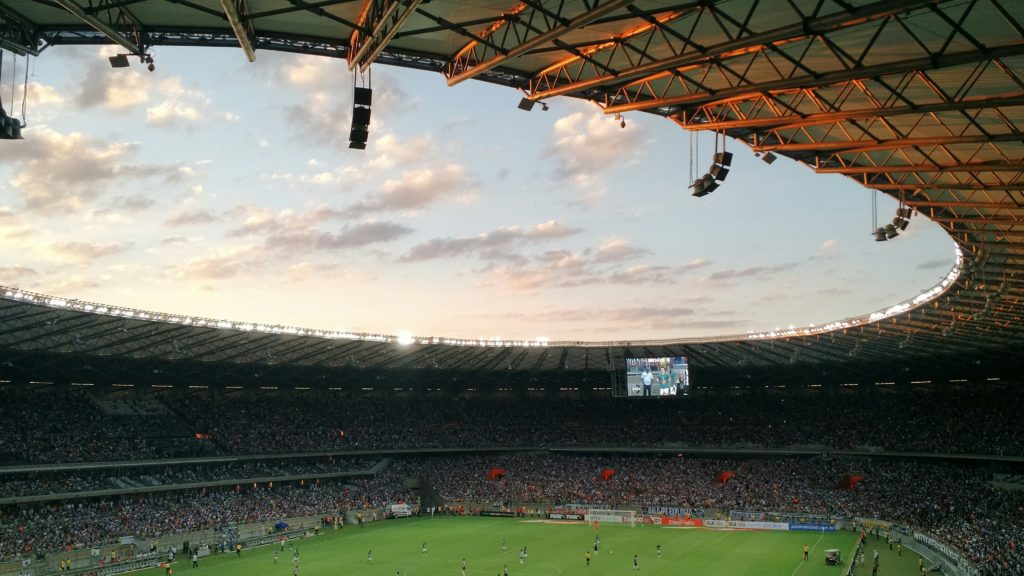Picture this: it’s match day. Fifty thousand fans surge through the gates, turnstiles click in rhythm, stewards coordinate via headsets, and a network of cameras and access systems hum quietly in the background….

It looks effortless – but behind every seamless entry and secure zone lies one of the most complex security operations in the modern world.
In 2025, stadium security has become both an art and a science. It’s not just about keeping people safe; it’s about managing vast, dynamic spaces that change function overnight from football matches to sold-out concerts, from corporate events to community gatherings. The challenge is no longer simply to protect, but to protect fully and intelligently.
The stakes have never been higher. With the introduction of Martyn’s Law (the Terrorism Protection of Premises Bill) and rising public expectations around safety, stadiums across the UK and Ireland are being forced to rethink how they manage access, monitor movement, and prepare for emergencies. At the same time, operators want systems that enhance fan experience, cut maintenance costs, and align with sustainability goals.
This convergence of compliance, technology, and customer experience is creating opportunity for Value Added Resellers (VARs) and installers who specialise in access control. The venues that once relied on multiple mechanical locks now need intelligent, auditable, and connected security ecosystems and the partners who can deliver them stand to win big.
SimonsVoss, with its heritage in digital locking and wireless access control, sits at the centre of this transformation. For VARs and installers ready to expand into high-value, large-venue projects, stadium security in 2025 represents a perfect storm of demand, innovation, and long-term growth.
The global stadium security market is estimated at USD 14.01 billion in 2025, projected to reach USD 24.3 billion by 2030, an annual growth rate of over 11% (Mordor Intelligence).
For Value Added Resellers (VARs) and installers, this growth represents a significant commercial opportunity. The key lies in offering scalable, low-maintenance, and integrated access-control solutions that help venue operators meet new challenges in 2025 and beyond.
Evolving Security Landscape: Why Stadiums Are Changing Fast
1. Increased Security Complexity
Modern stadiums are no longer single-use facilities. They host sports, concerts, conferences, and community events, each with distinct crowd patterns and security requirements. This complexity creates challenges in managing staff access, restricted zones, and emergency egress without slowing down operations.
2. Rising Investment in Technology
Stadiums are investing heavily in smarter security systems, from AI-driven CCTV and perimeter detection to wireless access control. The Mordor Intelligence report
notes that hardware and integrated systems currently make up over 54% of stadium security spending, but the fastest-growing segment is services; installation, integration, and maintenance.
3. Access Control Becomes Mission-Critical
Access control is no longer an afterthought. It now underpins staff management, crowd control, VIP safety, and emergency procedures. Smart digital locking provides real-time visibility, credential control, and audit trails, helping stadiums comply with legislation while improving fan experience.
4. Demand for Long-Term Reliability
Venues increasingly want systems that can evolve and are scalable, wireless, and future-proof, with minimal downtime. Stadiums that once replaced locking hardware every few years now seek modular, upgradeable systems with a lifespan of a decade or more.
Understanding Martyn’s Law: A Turning Point for Stadium Security
The most significant regulatory change shaping UK venue security in 2025 is the upcoming Martyn’s Law.
Named after Martyn Hett, one of the victims of the 2017 Manchester Arena attack, the law aims to make public venues more resilient to terrorism by requiring them to plan and prepare for potential threats.
What Martyn’s Law Means for Stadiums and Large Venues

Mandatory Preparedness:
Venues will be legally required to assess risks and implement proportionate protective measures against terrorist attacks.
Scope and Scale:
The law applies to venues with a capacity of 100 people or more, but enhanced duties apply to larger sites, particularly those with 2,500+ capacity, a category that includes nearly all professional stadiums and arenas.
Core Requirements Include:
- Conducting regular terrorism risk assessments
- Developing incident response and evacuation plans
- Training staff on recognising and responding to threats
- Maintaining secure access controls to restrict unauthorised entry
- Integrating physical and digital security systems for rapid coordination
Penalties for Non-Compliance:
Venues that fail to comply face significant fines, reputational damage, and potential criminal liability.
Implications for Installers and VARs
Martyn’s Law will accelerate demand for auditable, high-integrity access-control solutions. Stadiums will need to demonstrate:
- Controlled entry to restricted zones (players’ tunnels, command centres, hospitality areas)
- Comprehensive audit trails showing who accessed where and when
- Integration with incident-management systems to support emergency response
- This creates clear opportunity for VARs and installers who can supply and integrate systems capable of meeting these obligations.
How SimonsVoss Helps Stadiums Comply
SimonsVoss digital locking systems are designed for precisely this environment:
- Audit-trail capability for compliance verification
- Wireless, encrypted access control for secure, traceable entry
- Modular design to retrofit across legacy stadium infrastructures
- Remote credential management, enabling rapid lockdown or access changes
In short, SimonsVoss technology provides the digital backbone for Martyn’s Law compliance, while helping venues modernise and improve efficiency.
Opportunities for VARs & Installers
A. Retrofitting Legacy Systems
Many stadiums still rely on outdated mechanical locks or wired systems. The need to comply with Martyn’s Law, along with rising insurance and safety requirements, will drive large-scale retrofits. Wireless systems from SimonsVoss can be installed quickly, reducing cabling and downtime which is an immediate advantage for installers.
B. Full Lifecycle Services
Stadiums now expect service contracts that include maintenance, compliance audits, and credential management. VARs that deliver this end-to-end support will become trusted long-term partners, not just contractors.
C. Integrated Digital Ecosystems
Access control increasingly integrates with video analytics, ticketing, and building-management systems. Installers skilled in integration can provide comprehensive “smart stadium” solutions that improve operational efficiency and enhance safety.
D. Sustainability as a Sales Advantage
Modern venues also face sustainability targets. Wireless access control systems from SimonsVoss support these objectives by eliminating cabling, reducing energy use, and offering long product lifecycles; a compelling argument for environmentally conscious clients.
E. Expansion into Event Overlays and Temporary Zones
Concerts and non-sporting events require quick setup of temporary secure areas. Portable, programmable systems allow fast deployment, an emerging revenue stream for agile installers.
Technical Considerations for Stadium Projects
- Scalability – Stadiums require systems that can support thousands of users and hundreds of doors without performance loss.
- Integration – Access control must communicate with CCTV, ticketing, and emergency systems.
- Cybersecurity – As systems become networked, encryption and firmware integrity are vital.
- Reliability – High-footfall environments demand hardware tested for durability.
- Compliance – Installers should be ready to advise on Martyn’s Law readiness and documentation.
SimonsVoss: Engineered for Stadium-Scale Security
SimonsVoss has delivered smart locking systems for stadiums, universities, hospitals, and government buildings across Europe. Our technology combines German precision engineering with intuitive digital management, ideal for venues requiring both flexibility and resilience.

Key Benefits for Stadium Operators:
- Wireless, battery-powered digital cylinders and SmartHandles
- Up to 10-year battery life, reducing maintenance disruption
- Seamless integration into security management systems
- Audit-trail and time-zone functionality for compliance control
- Rapid credential changes via central or cloud-based software
For VARs and installers, partnering with SimonsVoss means access to:
- Full technical training and certification
- Design and specification support for tender bids
- Lifecycle support and partner marketing resources
Case Example: Northampton Saints RFC
When Northampton Saints upgraded their stadium security, they needed a solution that could handle heavy match-day traffic, improve accountability, and reduce maintenance downtime.
SimonsVoss installed a wireless digital locking system that eliminated mechanical keys, introduced programmable transponders, and created full audit visibility across staff and contractor access.
“We’re now entering a keyless world using the SimonsVoss transponder. The audit trail allows us to see who was where at what times, which has fundamentally tightened up our processes.”
– Kristy Coates, Head of Operations, Northampton Saints RFC

The result: greater efficiency, stronger compliance, and a foundation aligned with upcoming Martyn’s Law requirements.
Read more about How Northampton Saints enhanced their security with SimonsVoss digital locks.
Installer & VAR Strategy: How to Succeed in This Market
1. Understand Venue Operations
Learn how stadiums operate on event and non-event days, including access hierarchies, hospitality flows, and emergency protocols.
2. Build Expertise in Compliance & Integration
Position yourself as a consultant who understands Martyn’s Law, ISO 27001 cybersecurity principles, and building-safety regulations.
3. Offer Long-Term Support
Develop maintenance and upgrade packages, ensuring the stadium’s access system stays compliant and current.
4. Use Data to Demonstrate Value
Provide reporting on access events, energy savings, and reduced maintenance; metrics that facility managers can use for compliance audits.
5. Partner with Trusted Manufacturers
Work with technology providers that offer durability, training, and a proven track record in high-security environments. SimonsVoss delivers all three.
Market Outlook and Why Now Is the Time
With the combination of Martyn’s Law, rising event-security awareness, and smart-stadium digitalisation, the next five years will be transformative.
Analysts at Future Market Insights predict double-digit annual growth in stadium security, driven by integrated access-control and maintenance services. Installers who act now can secure early-mover advantage before competition intensifies.
For VARs, this is not a niche, it’s a scalable business vertical with high-value contracts, recurring service revenue, and strong brand visibility.
Secure, Compliant, and Future-Ready
Stadiums in 2025 face a balancing act between fan experience, operational efficiency, and legal compliance. The arrival of Martyn’s Law cements the need for robust, auditable, and adaptable access-control infrastructure.
For installers and VARs, this is the moment to lead. By aligning with SimonsVoss, you can deliver technology that helps venues meet regulatory requirements, reduce maintenance costs, and prepare for the next decade of digital stadium management.
Smart, sustainable, and secure access control doesn’t just protect stadiums, it powers their future.
Interested in partnering with SimonsVoss?
FAQs: Stadium Security and Access Control in 2025
Martyn’s Law will require public venues, including stadiums and arenas, to assess terrorism risks and implement proportionate security measures. For large venues with a capacity above 2,500, the law introduces enhanced duties such as staff training, access control, and emergency planning. Stadium operators will need to demonstrate auditable systems and procedures for protecting the public, which will drive major investment in digital access control.
Modern stadiums host multiple events and thousands of daily staff, contractors, and visitors. Access control ensures only authorised individuals can enter restricted zones such as player areas, VIP suites, and operations rooms. Beyond security, it also supports compliance, crowd management, and operational efficiency by integrating with ticketing, CCTV, and emergency systems.
The demand for modern, compliant, and integrated access control systems is growing quickly. VARs and installers can win long-term contracts by offering wireless, auditable solutions that help stadiums meet Martyn’s Law obligations. Ongoing maintenance, credential management, and system upgrades create recurring revenue streams far beyond initial installations.
Stadiums need scalable, modular, and networked systems that support thousands of credentials and doors without complexity. Wireless digital locking, smart handles, and battery-powered cylinders are ideal because they reduce cabling, installation time, and maintenance. Systems with real-time monitoring and central credential control provide the visibility and resilience required for high-traffic environments.
SimonsVoss systems combine German engineering with intelligent digital design. Features include encrypted wireless communication, long battery life (up to 10 years), full audit trails, time-zone controls, and rapid credential management. These capabilities help venues meet Martyn’s Law requirements while enhancing operational agility and fan safety.
Key challenges include legacy infrastructure, tight upgrade windows, integration with multiple IT and safety systems, and strict compliance standards. Installers must also manage large user databases and complex access hierarchies. Partnering with an experienced manufacturer like SimonsVoss ensures you have the technical and logistical support to deliver large-scale projects effectively.
SimonsVoss provides full technical training, certification programmes, and partner resources covering product installation, integration, and tender support. Partners also gain access to expert design assistance, marketing materials, and post-installation service guidance to help build lasting client relationships.
